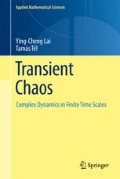Abstract
In numerical or experimental investigations one never has infinitely long time intervals at one’s disposal. In fact, what is needed for the observation of chaos is a well-defined separation of time scales. Let t 0 denote the internal characteristic time of the system. In continuous-time problems, t 0 can be the average turnover time of trajectories on a Poincaré map in the phase space. In a driven system, it is the driving period. In discrete-time dynamics, t 0 can be the time step itself.
Access this chapter
Tax calculation will be finalised at checkout
Purchases are for personal use only
Notes
- 1.
For instance, in the time-reversed dynamics of an invertible system possessing a chaotic attractor and a coexisting chaotic saddle.
- 2.
There are situations in which the decay follows a power law for certain types of nonhyperbolic chaotic sets, which will be treated in Sect. 2.4Nonhyperbolic Transient Chaos in One Dimension and Intermittencysection.2.4.179 and Chap. 6Chaotic Scatteringchapter.6.546. Such decays cannot be characterized by escape rates.
- 3.
The prefactor N yields what the number of initial points would be if the decay were exponential from the very beginning. Therefore N is different from N 0.
- 4.
For continuous-time systems, (1.5)–(1.8) remain valid under the transform n → t. The escape-time distribution becomes then a probability density, and the sum in (1.9) is replaced by an integral. The escape rate in the corresponding continuous-time system is κ ∕ t 0, where t 0 denotes the internal characteristic time mentioned in the introduction to this chapter. Analogously, the average lifetime can be estimated as t 0 ∕ κ.
- 5.
- 6.
Because of the analogy between μc and μs, we can also call the conditionally invariant measure the measure of the unstable manifold.
- 7.
The positivity of the largest Lyapunov exponent cannot be taken as a criterion because of the example of an isolated saddle point.
Author information
Authors and Affiliations
Corresponding author
Rights and permissions
Copyright information
© 2011 Springer Science+Business Media, LLC
About this chapter
Cite this chapter
Lai, YC., Tél, T. (2011). Introduction to Transient Chaos. In: Transient Chaos. Applied Mathematical Sciences, vol 173. Springer, New York, NY. https://doi.org/10.1007/978-1-4419-6987-3_1
Download citation
DOI: https://doi.org/10.1007/978-1-4419-6987-3_1
Published:
Publisher Name: Springer, New York, NY
Print ISBN: 978-1-4419-6986-6
Online ISBN: 978-1-4419-6987-3
eBook Packages: Mathematics and StatisticsMathematics and Statistics (R0)

